Published on Sep 22, 2025
Daily PIB Summaries
PIB Summaries 22 September 2025

Content
- Tripura Sundari Temple: A New Dawn for Spiritual Tourism in the North-East
- Seeds of the Future: Clean Plant Programme Gaining Momentum
Tripura Sundari Temple: A New Dawn for Spiritual Tourism in the North-East
Why in News
- On 22 September 2025, Prime Minister Narendra Modi will inaugurate the redeveloped Tripura Sundari Temple in Udaipur, Gomati district, Tripura.
- The project, sanctioned in 2020–21 under PRASHAD scheme with an outlay of ₹34.43 crore, has upgraded facilities, connectivity, and spiritual tourism infrastructure.
- The event highlights the government’s focus on making the North-East a hub for spiritual and heritage tourism, linking it with the vision of “Vikas Bhi, Virasat Bhi” and Viksit Bharat 2047.
Relevance
- GS1: Indian heritage, Shakti Peethas, syncretism in NE traditions.
- GS2: Centre–State coordination in PRASHAD, tourism governance.
- GS3: Infrastructure, sustainable tourism, employment, Act East policy.

PRASHAD Scheme – Overview
- Launch: 2015, Ministry of Tourism, Central Sector Scheme.
- Full Form: Pilgrimage Rejuvenation and Spiritual, Heritage Augmentation Drive.
- Coverage: 54 projects across 28 States/UTs till 2025.
- Objective:
- Provide world-class amenities at pilgrimage/heritage sites.
- Preserve sanctity while ensuring modern infrastructure.
- Generate local employment and promote sustainable tourism.

Significance of Tripura Sundari Temple Redevelopment
- Historical & Cultural:
- Built in 1501 A.D. by Maharaja Dhanya Manikya.
- One of the 51 Shakti Peethas; state’s name Tripura derives from Goddess Tripura Sundari.
- Known as Matabari and Kurma Pith (tortoise-shaped base).
- Redevelopment Features:
- Food court, multipurpose halls, Prasad ghar, modern sanitation, solar PV, storm-water management.
- 51 Shakti Peethas Park showcasing replicas → cultural branding.
- Impact:
- Positions Tripura as a major spiritual tourism hub.
- Connects with Kamakhya Temple (Assam) to strengthen a Shakti Circuit in NE India.
Broader Context – Spiritual Tourism in North-East
- Key Sites:
- Shaktism: Kamakhya (Assam), Tripura Sundari (Tripura), Parshuram Kund (Arunachal).
- Vaishnavism: Majuli Satras (Assam), Manipuri Raas traditions.
- Buddhism: Tawang (Arunachal), Rumtek (Sikkim), Mon monasteries (Nagaland).
- Cross-Border Potential: NE can attract pilgrims from Bangladesh, Nepal, Bhutan, Myanmar.
- Integration: Combines religious tourism + cultural festivals + eco-tourism, enhancing the Act East Policy outreach.
PRASHAD’s Role in NER
- Past Projects: Kamakhya (2015–16), Meghalaya (2020–21), Nagaland (2018–19, 2022–23), Mizoram (2022–23, 2024–25), Parshuram Kund (Arunachal, 2020–21), Yuksom (Sikkim, 2020–21).
- Model Shift: Moves NER from “periphery image” to core tourism circuit.
- Livelihoods: Expanding homestays, guides, handicrafts, eco-cultural enterprises.
Strategic Importance
- Economic: Spiritual tourism accounts for ~60% of India’s domestic travel. NER stands to gain from this market.
- Cultural Diplomacy: Positions India as custodian of Hindu, Buddhist, and syncretic traditions.
- Regional Balance: Ensures development beyond metros; integrates remote NE states into national mainstream.
- Vision 2047: Aligns with E-A-S-T principle (Empower, Act, Strengthen, Transform) for Northeast.
Challenges
- Connectivity bottlenecks (last-mile rail/road/air).
- Risk of over-tourism damaging fragile ecology.
- Sustaining sanctity vs commercialisation balance.
- Post-project maintenance and governance capacity.
Conclusion
The Tripura Sundari Temple inauguration is not just a religious event but a policy milestone:
- It illustrates how PRASHAD scheme is reshaping spiritual tourism by merging heritage preservation with infrastructure development.
- For the Northeast, it signifies a new dawn of temple tourism, linking faith with jobs, regional pride, and cultural diplomacy.
- Together, these efforts position the NER as a heritage-driven growth engine within the vision of Viksit Bharat 2047.
Seeds of the Future: Clean Plant Programme Gaining Momentum
Why in News
- On 21 September 2025, the Ministry of Agriculture highlighted progress of the Clean Plant Programme (CPP) through field actions, hazard analysis, lab assessments, and nursery evaluations.
- CPP, approved in August 2024 with ₹1,765.67 crore outlay (including $98M ADB loan), is emerging as a transformative horticulture initiative.
Relevance
- GS2: Government policies & interventions (Agriculture, Horticulture, One Health approach).
- GS3: Science & Technology in agriculture, climate resilience, food security, exports.
- GS1: Role of horticulture in rural livelihoods, nutrition, equitable development.

What is the Clean Plant Programme?
- Definition: A centrally approved initiative to provide farmers with virus-free, high-quality planting material for horticultural crops.
- Nodal Agency: National Horticulture Board (NHB).
- Technical Support: Indian Council of Agricultural Research (ICAR).
- Funding: ₹1,765.67 crore (includes ADB loan).
- Core Idea: Prevention of systemic diseases (viruses, pathogens) at the seed/planting material stage → healthier crops, higher yields, lower losses.
Key Features
- 9 Clean Plant Centres planned (3 in Maharashtra: Pune for grapes, Nagpur for oranges, Solapur for pomegranates).
- Modern nurseries: ₹3 crore for large, ₹1.5 crore for medium; target to produce 8 crore disease-free seedlings annually.
- National laboratory in Pune: For original plant species research.
- International Cooperation: Israel, Netherlands for technology & expertise.
- Process: Acquire → test → treat (if infected via tissue culture, cryo, heat therapy) → propagate → distribute.
On-Ground Progress (2024–25)
- Website launched: Central hub for CPP resources (cpp-beta.nhb.gov.in).
- Hazard analysis completed for grapevine (578 samples tested); underway for apples (535 samples).
- Nursery visits: Maharashtra (2024) and J&K (2024) for climate-specific evaluation.
- Laboratory assessments: Bioinformatics pipeline for high-throughput sequencing (HTS).
- First Clean Plant Centre: Bidding underway for design.
Benefits of CPP
- For Farmers: Higher yields, income stability, reduced losses from viral outbreaks.
- For Nurseries: Certification and infrastructure support.
- For Consumers: Better quality, nutritious fruits.
- For Exports: Stronger market credibility for Indian horticulture produce.
- For Equity & Inclusion: Access ensured for small/marginal farmers; women farmers integrated into training & planning.
Broader Significance
- Climate Resilience: Virus-free crops more tolerant to stress; helps adapt to rising pest-disease interactions under climate change.
- Economic Impact: Horticulture already contributes >30% of agriculture GDP; CPP boosts India’s competitiveness.
- Food Security: Enhances fruit quality, reduces post-harvest losses.
- Health & Nutrition: Supports India’s focus on nutrition-sensitive agriculture.
Alignment with Wider Initiatives
- Mission LiFE (COP26): CPP promotes sustainable farming by reducing pesticide dependence.
- One Health Approach: Plant health → directly linked with human, animal, environmental health.
- MIDH (Mission for Integrated Development of Horticulture): Complements MIDH’s goals of productivity boost (12.56 MT/ha in 2024–25 from 12.10 MT/ha in 2019–20).
Challenges
- Ensuring wide adoption by small/marginal farmers.
- Capacity of state agricultural universities and labs to scale up diagnostics.
- Certification compliance and monitoring across thousands of nurseries.
- Need for sustained funding and international technology exchange.
Conclusion
- CPP is shifting Indian horticulture from “cure” to “prevention” by investing in clean, disease-free planting material.
- With strong institutional backing (NHB, ICAR, ADB), CPP could become a game-changer like the Green Revolution and White Revolution—this time for horticulture.
- Future: Expansion to more crops (mango, guava, litchi, avocado, dragon fruit), digital certification systems, and farmer-centric training will determine CPP’s success.

